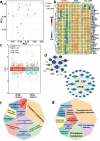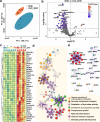Serum proteomic profiling reveals potential predictive indicators for coronary artery calcification in stable ischemic heart disease
- PMID: 40106019
- PMCID: PMC11923027
- DOI: 10.1007/s10735-025-10388-5
Serum proteomic profiling reveals potential predictive indicators for coronary artery calcification in stable ischemic heart disease
Abstract
Coronary artery calcification (CAC) is a common complication in patients with stable ischemic heart disease (SIHD). However, the early diagnosis and understanding of the pathogenesis of CAC in SIHD patients remain underdeveloped. This study aimed to analyze aberrant alterations in the serum proteome of SIHD patients, as well as SIHD patients with severe CAC (CAC_SIHD), and to explore the potential risk factors of CAC in SIHD patients. Serum proteomic profiles were obtained from individuals with SIHD (n = 6), CAC_SIHD (n = 6), and healthy controls (n = 9), and were analyzed using nano liquid chromatography tandem mass spectrometry (LC-MS/MS). The aberrant alterations in proteins and immune cells in the serum of SIHD and CAC_SIHD patients were characterized through differential protein expression analysis and single-sample gene set enrichment analysis analysis, respectively. Differentially expressed proteins (DEPs) were further subjected to gene ontology functional enrichment and Kyoto Encyclopedia of Genes and Genomes pathway enrichment analyses. Finally, Receiver Operating Characteristic analysis was performed on the DEPs between SIHD and CAC_SIHD to identify potential predictive factors of CAC. Abnormalities in multiple complement pathways and lipid metabolism were observed in SIHD and CAC_SIHD patients. Moreover, SIHD and CAC_SIHD were characterized by an increased presence of T cells and natural killer cells, along with a reduced presence of B cells. Subsequent analysis of serum proteins revealed that RNASE1 and MSLN may be potential predictive indicators for the early detection and diagnosis of CAC in SIHD patients. In conclusion, our research extensively examined the variations in serum proteins in patients with SIHD and CAC_SIHD, identifying key indicators and metabolic pathways associated with these conditions. These findings not only provide new insights into the pathological mechanisms of SIHD and CAC_SIHD, but also suggest potential factors for the early diagnosis of CAC in SIHD patients, which imply potential clinical applications.
Keywords: Coronary artery calcification (CAC); Ischemic heart disease (SIHD); MSLN; Proteomic; RNASE1.
© 2025. The Author(s).
Conflict of interest statement
Declarations. Ethics approval and consent to participate: The study was granted with the approval of the ethical committee of the First People’s Hospital of Yunnan Province (2016LH083) and conform the relevant ethical guidelines for human and animal research. Written informed consent has been obtained from the patient(s) to publish this paper. Conflict of interest: The authors declare no competing interests.
Figures








References
-
- Alexopoulos N, Raggi P (2009) Calcification in atherosclerosis. Nat Rev Cardiol 6(11):681–688 - PubMed
-
- Blaha M, Budoff MJ, Shaw LJ, Khosa F, Rumberger JA, Berman D, Callister T, Raggi P, Blumenthal RS, Nasir K (2009) Absence of coronary artery calcification and all-cause mortality. JACC Cardiovasc Imaging 2(6):692–700 - PubMed
MeSH terms
Substances
Grants and funding
LinkOut - more resources
Full Text Sources
Medical
Miscellaneous

